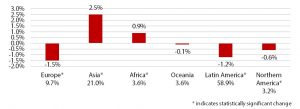Blog Post
Insight: Time to celebrate! New data from the American Community Survey
By: Mallory Bateman
Dec 19, 2019 – Today marks the release of the 2014-2018 5-Year American Community Survey (ACS) Estimates. The ACS is an ongoing survey that provides information on social, demographic, and economic characteristics of communities. The ACS began in 2008 and replaced the Census Long Form in 2010. Each year, we receive a new update to both the 1 and 5-Year Estimates. This is the second release shared on the new data.census.gov platform.
This release is particularly relevant for Utahns, because the 5-Year Estimates are available for all geographies, from the state down to census tracts. The 1-Year ACS Estimates are only provided for populations over 65,000. Additionally, this release allows us to compare with the 2009-2013 5-Year Estimates and see how things have changed.
In the national release, the focus was on the 65 and older population. Two counties were mentioned in the release, for their low and high rankings nationally. The new data shows that Utah County has one of the lowest shares of 65 and older people living alone and Summit County has one of the highest shares of 65 and over individuals with broadband subscriptions.
Since we have an ongoing data source, these releases do not typically come with shocking findings. However, they do reveal continuation of trends seen throughout the decade. Some of the major events that have influenced Utah’s demographics are: declining births and fertility rate, an aging population, increasing racial and ethnic diversity, and a strong economy.
When we dive into the local data, we see the impacts of all of these factors coming together. Although Utah is still the youngest state in the nation, the median age increased from 29.6 to 30.7. The share of population under age 18 decreased, while the share aged 65 and older increased. Similarly, family households with children under 18 decreased as a share of total households, while the share of 65 and older people living alone increased.
Statewide, the foreign-born population increased, as did the shifts in country of origin. The share of the foreign-born population from Asia increased by 2.5% between the two estimate periods, resulting in 21% of the foreign-born population in 2014-2018. The Latin American-born population decreased as a share, to 59%. The racial and ethnic minority population increased from 19% to 21%, with the largest increases in the non-Hispanic Asian and non-Hispanic Two or more race groups.
World Region of Foreign Born in Utah, Change from 2009-2013 to 2014-2018 with 2014-2018 Total Share

The strong economy was highlighted with an increased share of women in the labor force (56% to 58%), a higher share of households with children where all parents are working (50% to 52%), and increased median household incomes for the total population and for families. Once again, the influence of the aging population was seen, with the state and seven counties experiencing increases in the share of households receiving retirement income.

The 2020 Census will provide more clarity on these survey-based estimates for gender, household types, housing units, age, race, and ethnicity. The importance of a complete count cannot be overstated, as it provides the framework for the deployment of the future American Community Surveys and the baseline for demographic work at the Kem C. Gardner Policy Institute.
Mallory Bateman is a Senior Research Analyst and State Data Center Coordinator at the Kem C. Gardner Policy Institute.






